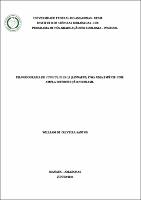| ???jsp.display-item.social.title??? |


|
Please use this identifier to cite or link to this item:
https://tede.ufam.edu.br/handle/tede/10461| ???metadata.dc.type???: | Dissertação |
| Title: | Filogeografia de Cuniculus paca (Linnaeus, 1766): uma espécie com ampla distribuição no Brasil |
| Other Titles: | Phylogeography of Cuniculus paca (Linnaeus, 1766): a widely distributed species in Brazil |
| ???metadata.dc.creator???: | Santos, William de Oliveira  |
| ???metadata.dc.contributor.advisor1???: | Farias, Izeni Pires |
| ???metadata.dc.contributor.referee1???: | Gravena, Waleska |
| ???metadata.dc.contributor.referee2???: | Silva, Carlos Eduardo Faresin e |
| ???metadata.dc.description.resumo???: | Cuniculus paca é o segundo maior roedor dentro do Brasil, pertencente à família Cuniculidae e que tem sua área de distribuição nos neotrópicos, desde Uruguai e Argentina até o Sul do México, amplamente distribuída no território brasileiro. No Brasil, são conhecidas duas subespécies: C. paca paca com localidade tipo para Pernambuco e C. paca mexianae com localidade tipo para a Ilha de Mexiana no Pará, mas seus limites e área de distribuição ainda são desconhecidos. Cuniculus paca é amplamente utilizada como recursos de subsistência pelas comunidades tradicionais, devido aos custos e pela similaridade organoléptica com a proteína de frango, com uma pressão de caça de 0,4 indivíduos/km² e estima-se que cerca de 8% de toda carne selvagem consumida seja da espécie. Alguns trabalhos já foram desenvolvidos para a Amazônia internacional, mas ainda nenhum para a Amazônia brasileira, nem em outros biomas do país. Estudos esses que apresentaram resultados parciais por apresentarem N amostral restrito e insuficiente. Neste trabalho utilizamos como marcador molecular o gene mitocondrial da Citocromo Oxidase I (COI), amostrando a maior área possível dentro da distribuição da espécie para o território brasileiro com maior número possível de amostras, também incorporando as sequências geradas em outros estudos para a Amazônia Internacional. Com o auxílio do protocolo de DNA Barcoding, foram analisadas 69 sequências de 26 localidades diferentes ao longo do território brasileiro. Foram realizadas análises de estruturação das populações e delimitações de linhagens evolutivas intraespecíficas para o táxon. Ao todo foram encontradas três populações bem definidas pela análise do fastBAPS, sendo duas na Amazônia e uma na Mata Atlântica, com distâncias genéticas que variaram de 1,92% a 4,52%. Dentro da Amazônia essa variação populacional é observada como duas grandes populações, uma que ocorre no norte da Amazônia e outra que ocorre ao longo das proximidades do Rio Madeira e escudo brasileiro. Quanto às linhagens evolutivas, foram encontradas duas para o território brasileiro, sendo uma amazônica e outra da mata atlântica, identificadas por quatro análises de delimitação: Locmin, PTP, bGMYC e ABGD (Automatic Barcode Gap Discovery). Essas linhagens não estão associadas à distribuição das subespécies sugeridas para o Brasil, logo, outras amostras de outras regiões devem ser incorporadas em trabalhos futuros para um melhor entendimento das diversidade dentro de C. paca. |
| Abstract: | Cuniculus paca is the second largest rodent in Brazil, belonging to the Cuniculidae family and which has its distribution area in the Neotropics, from Uruguay and Argentina to Southern Mexico, widely distributed in Brazilian territory. In Brazil, two subspecies are known: C. paca paca with type locality for Pernambuco and C. paca mexianae with type locality for Ilha de Mexiana in Pará, but its limits and distribution area are still unknown. Cuniculus paca is widely used as subsistence resources by traditional communities, due to the costs and organoleptic similarity with chicken protein, with a hunting pressure of 0.4 individuals/km² and it is estimated that around 8% of all meat wild consumed is of the species. Some work has already been developed for the international Amazon, but none yet for the Brazilian Amazon, nor in other biomes in the country. These studies presented partial results due to a restricted and insufficient sample size. In this work, we used the mitochondrial Cytochrome Oxidase I (COI) gene as a molecular marker, sampling the largest possible area within the distribution of the species for the Brazilian territory with the largest possible number of samples, also incorporating sequences generated in other studies for the International Amazon. With the help of the DNA Barcoding protocol, 69 sequences were analyzed from 26 different locations throughout Brazilian territory. Population structuring analyzes and delimitations of intraspecific evolutionary lineages for the taxon were carried out. In total, three well-defined populations were found by the fastBAPS analysis, two in the Amazon and one in the Atlantic Forest, with genetic distances ranging from 1.92% to 4.52%. Within the Amazon this variation is observed as two large populations, one that occurs in the north of the Amazon and another that occurs along the Madeira River and Brazilian shield. Regarding evolutionary lineages, two were found for Brazilian territory, one from the Amazon and the other from the Atlantic forest, identified by four delimitation analyses: Locmin, PTP, bGMYC and ABGD (Automatic Barcode Gap Discovery). These lineages are not associated with the distribution of the subspecies suggested for Brazil, and therefore other samples from other regions should be incorporated in future work to better understand the diversity within C. paca. |
| Keywords: | Pacas Genética animal |
| ???metadata.dc.subject.cnpq???: | CIENCIAS BIOLOGICAS: GENETICA CIENCIAS BIOLOGICAS: GENETICA: GENETICA ANIMAL |
| ???metadata.dc.subject.user???: | Variabilidade genética DNA Barcoding COI (Citocromo oxidase subunidade 1) Delimitação Linhagens evolutivas e estruturação de populações |
| Language: | por |
| ???metadata.dc.publisher.country???: | Brasil |
| Publisher: | Universidade Federal do Amazonas |
| ???metadata.dc.publisher.initials???: | UFAM |
| ???metadata.dc.publisher.department???: | Instituto de Ciências Biológicas |
| ???metadata.dc.publisher.program???: | Programa de Pós-graduação em Zoologia |
| Citation: | SANTOS, William de Oliveira. Filogeografia de Cuniculus paca (Linnaeus, 1766): uma espécie com ampla distribuição no Brasil. 2024. 39 f. Dissertação (Mestrado em Zoologia) - Universidade Federal do Amazonas, Manaus, 2024. |
| ???metadata.dc.rights???: | Acesso Aberto |
| ???metadata.dc.rights.uri???: | https://creativecommons.org/licenses/by-nc-nd/4.0/ |
| URI: | https://tede.ufam.edu.br/handle/tede/10461 |
| Issue Date: | 27-Jun-2024 |
| Appears in Collections: | Mestrado em Zoologia |
Files in This Item:
| File | Description | Size | Format | |
|---|---|---|---|---|
| DISS_WilliamSantos_PPGZOOL.pdf | 7.38 MB | Adobe PDF |  Download/Open Preview |
Items in DSpace are protected by copyright, with all rights reserved, unless otherwise indicated.




